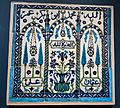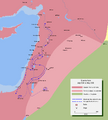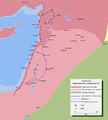Rashidun Empire facts for kids
Quick facts for kids
Rashidun Caliphate
الخلافة الراشدية
|
|||||||||
|---|---|---|---|---|---|---|---|---|---|
| 632–661 | |||||||||
|
Flag
|
|||||||||
| Capital | Medina, Kufa | ||||||||
| Common languages | Arabic, Aramaic, Armenian, Berber languages, Georgian, Greek, Hebrew, Middle Persian | ||||||||
| Religion | Islam | ||||||||
| Amir al-Mu'minin¹ | |||||||||
|
• 632–634
|
Abu Bakr | ||||||||
|
• 634–644
|
Umar | ||||||||
|
• 644–656
|
Uthman | ||||||||
| History | |||||||||
|
• Muhammad's death
|
632 | ||||||||
|
• Ali's death
|
661 | ||||||||
| Area | |||||||||
| 9,000,000 km2 (3,500,000 sq mi) | |||||||||
| Population | |||||||||
|
•
|
40300000 | ||||||||
| Currency | Dinar, Dirham | ||||||||
|
|||||||||
|
¹ Amir al-Mu'minin (أمير المؤمنين), Caliph (خليف)
|
|||||||||
The Rashidun Caliphate was an early Islamic empire. It was led by the first four leaders who followed Prophet Muhammad. These leaders are often called the "Rightly Guided Caliphs."
The empire began in 632 after Muhammad passed away. It lasted until 661, when the fourth leader, Ali, died. At its strongest, the Rashidun Caliphate stretched across North Africa, the Arabian Peninsula, and parts of Iran.
Contents
How the Rashidun Caliphate Began
After Muhammad's death in 632, the Muslim community in Medina needed a new leader. They chose Abu Bakr to be the first leader. He was called the Khalifa Rasul Allah, meaning "Successor of the Messenger of God."
Abu Bakr started campaigns to unite the Muslim community. He brought back Arabian tribes that had left Islam. As a Khalifa, or Caliph, he was not a king. None of the first four Caliphs ever claimed to be a monarch.
Early Military Leaders and Strategies
The first important general of the empire was Khalid ibn al-Walid. He was known for his amazing tactics. Khalid led campaigns against the Persian Empire (in Iraq) and the Byzantine Empire (in Syria).
The Caliphs had different ways of leading their armies:
- Abu Bakr gave his generals their mission and resources. He let them decide how to achieve their goals.
- Umar was more hands-on. He told his generals where to go and when to move. He even decided who would lead different parts of the army. This made conquests slower but more organized.
- Uthman used a similar method to Abu Bakr. He gave missions and let his generals figure out the details.
- Ali also followed Abu Bakr's method of leadership.
Religion in the Caliphate
The main religion of the Rashidun Caliphate was Islam. However, people who were not Muslim were allowed to practice their own religions. The laws of the state were based on Sharia Law.
Islam guided everything in the Caliphate. Any action by the government had to be approved by the Quran and the teachings of Prophet Muhammad. If there were no clear guidelines, leaders used their wisdom. But if an action went against established principles, it was not carried out.
Images for kids
-
Map showing the route of Khalid ibn al-Walid's conquest of Iraq.
-
A Rashidun Caliphate coin, imitating the style of Sasanid Empire ruler Khosrau II.
-
Map showing the Rashidun Caliphate's invasion of the Levant.
-
Map showing the route of Khalid ibn al-Walid's invasion of Syria.
-
Al-Jami'a Al-Aqsa in Al-Haram Ash-Sharif, Old City of Jerusalem, 1982.
-
Map showing the route of Khalid ibn al-Walid's invasion of Eastern Anatolia and Armenia.
-
The Grand Mosque of Khartoum, Sudan, 2013.
See also
 In Spanish: Califato ortodoxo para niños
In Spanish: Califato ortodoxo para niños





















